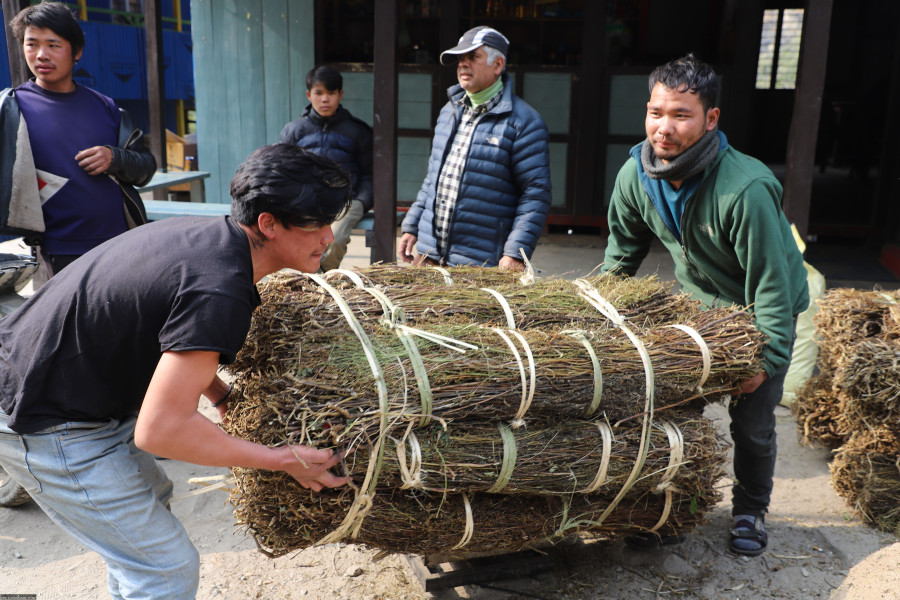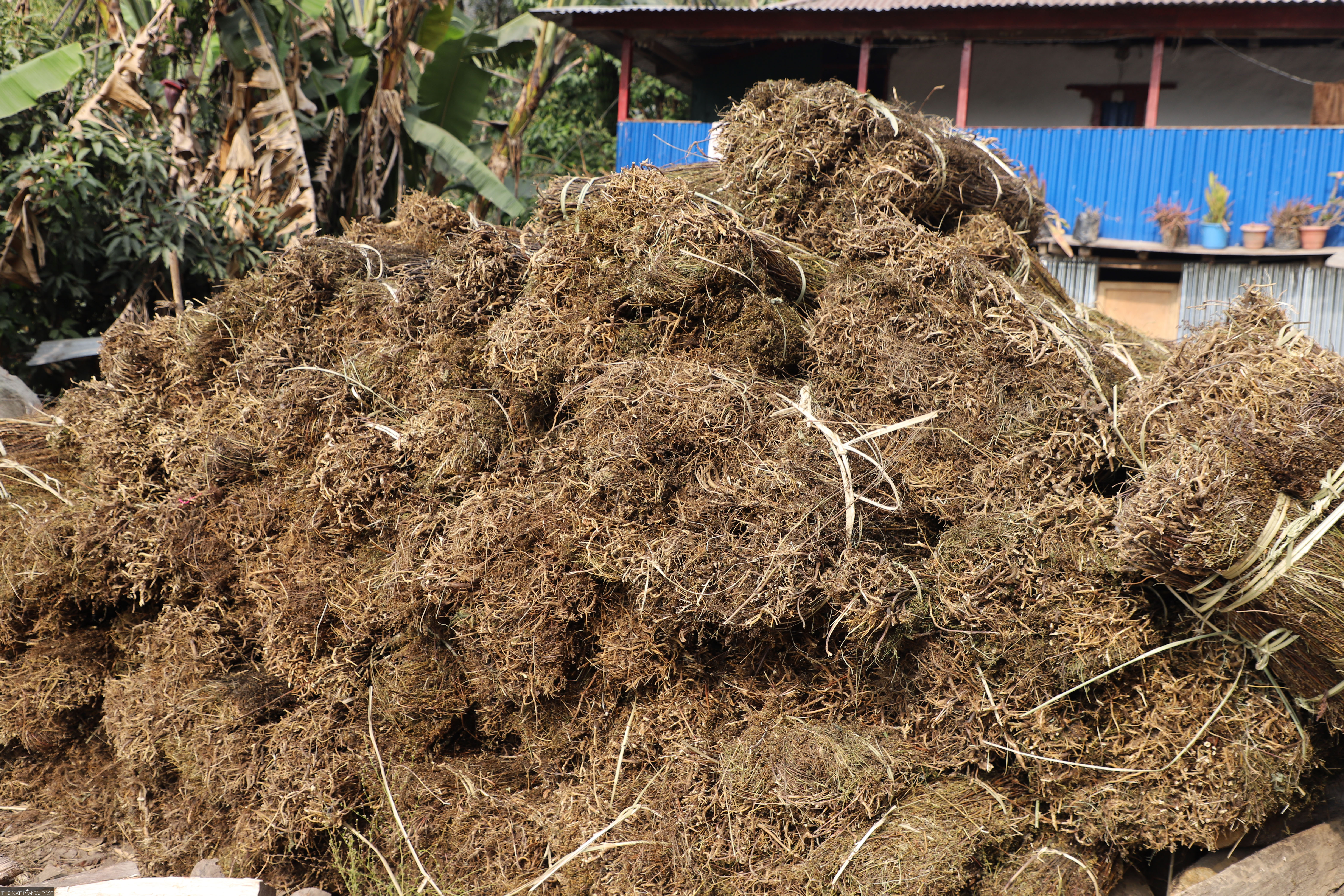Money
Chiraito herb hits all-time high of Rs1,000 per kg
Tibet used to be the largest buyer of the plant; but after China closed the border, traders turned their attention to India.
Ananda Gautam
The price of chiraito, a medicinal herb prized by the pharmaceutical industry, has hit an all-time high of Rs1,000 per kg on soaring demand in India. The plant (Swertia chirayita) grows wild in the forests of the Himalayan foothills, and is also cultivated.
Tibet used to be the largest buyer of Nepali chiraito; but after Chinese authorities closed the border in eastern Nepal due to Covid-19, herb traders turned their attention to India.
Yak caravans used to haul pack loads of the herb through Olangchung Gola in eastern Nepal to Tibet. Exports stopped since 2020 when the pandemic broke out, and the northern border was tightly shut.
Chiraito prices have been fluctuating as per demand in China and India. Traders ship their products to whichever market offers a higher price.
Hari Mishra, a trader from Birtamod, Jhapa is busy these days as chiraito exports to India have swelled. The northern border is still closed.
Germany, Sweden, Italy, Holland and the United States also buy Nepali chiraito, but in small quantities.
Dried chiraito is packed into 1-kg bundles of about 1 metre in length. According to a report, it is used as a tonic, febrifuge and antidiarrhetic, and also as a cure for various liver problems.
The plant is used to control the blood sugar level. The plant shows antipyretic, sudorific, antiperiodic, anthelmintic, anti-inflammatory and hepatoprotective actions, and is used in urinary and liver disorders, and is reported to have a wide spectrum of pharmacological properties.
“This year the price has reached a record level,” said Mishra, who collects the plants from the eastern mountain district of Taplejung, and exports them to India.
He has been in the business for the past one and a half decades. Last year, the price of chiraito was Rs750 per kg, he said.
Another trader Govinda Baral of Hangdewa in Phungling Municipality-9 said farmers were elated by the increase in price.
The chiraito plant is 0.6-1.5 metres tall. Its stem is orange-brown or purplish in colour with a large continuous yellowish pith.
Buddhi Man Limbu of Lawajin in Phaktanglung Rural Municipality-6 said they were able to sell the medicinal herb at a good price this year.
The freight charge from Taplejung to Birtamod is Rs50,000 to Rs60,000 for a truckload, traders say. A truck can carry 2.4 tonnes of chiraito.
“As we have to collect the herb from villages in the mountains, the transportation cost is high,” said Baral. He said that traders pay an export tax of Rs5 per kg. Another tax of Rs15 per kg is imposed by the Division Forest Office.

Rudra Adhikari, from Panchthar district which adjoins Taplejung, also collects chiraito. He says transporting chiraito is more difficult than large cardamom and other crops.
“We have to start making the documents necessary to export chiraito as early as four months in advance. Vehicles carrying medicinal herbs are frequently stopped for strict security checks,” Adhikari said.
“Farmers do not want to go through such hassles, and prefer that traders come to their homes to collect the herb.”
Around 35 tonnes of chiraito can be collected in a year in Taplejung, according to the statistics of the Division Forest Office.
Only half of the pickers are issued permits. According to the forest office, it collects Rs250,000 in royalty from chiraito pickers annually.
"The medicinal herb becomes ready for collection 28 months after planting," said Birendra Sah, division forest officer.
In two years, a well-grown chiraito plant can be as tall as 1.5 metres, according to farmers.
There are 27 species of chiraito which are divided into male and female, according to Sah. “Chiraito is a native species in the Himalayan region, and can be found at altitudes ranging from 1,700 to 3,500 metres.”
Chiraito is an integral part of Ayurved, Yunani, Chinese and Tibetan medication systems, and is also used in herbal medicine systems in the United States and the United Kingdom, according to a report. The whole plant is intensely bitter in taste.
The highest consumption of chiraito is in Mumbai and Patna of India, said trader Mishra.
The plant starts flowering in mid-July and ripens from mid-September to mid-December.
Chiraito should be stored in a properly ventilated room in stacks weighing around 1 kg,” said Suraj Ojha, district chairman of the Federation of Community Forestry Users, Nepal. “We have carried out an awareness programme to collect the herb only after it fully ripens.”
Farmers in the district have started growing chiraito commercially too.
Traders say that farmers stopped growing the plant after exports to India and China stopped following the Covid-19 pandemic.
“While the price has increased, output has decreased,” said Mishra. “As a result of the drop in production, pharmaceutical companies are facing a shortage of the herb.”
The medicinal herb is exported to India from the eastern part of the country through Kakarbhitta and Jogbani customs points. Shipments to China are yet to resume since the coronavirus pandemic brought trade to a halt.
According to the statistics of the Mechi Customs Office, 118.5 tonnes of chiraito worth Rs22.4 million was exported to India in the first five months of the current fiscal year.




 11.12°C Kathmandu
11.12°C Kathmandu














